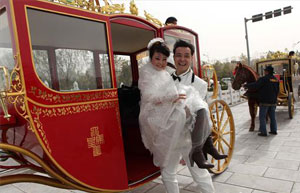Indian Navy to acquire anti-submarine bombs
Updated: 2010-10-31 14
(Xinhua)
NEW DELHI - The Indian Navy is to acquire anti-submarine bombs for its aviation fleet in a bid to bolster its underwater warfare capability, defense sources said on Sunday.
"The bombs would be air-dropped to hit enemy vessels lurking in dark underwaters. The explosives will also be capable of being dropped from an aircraft for engaging a submarine in deep waters and those on surface and periscope depths. The bombs will be bought for the Indian Navy's fixed-wing aircraft only," the sources said.
The Navy's aviation wing consists of Sea Harrier and MiG-29K fighter jets, Tupolev Tu-142 bomber, Dornier and IL-38 patrol aircraft, apart from Kamov, Sea King, Dhruv ALH, Chetak and Cheetah helicopters.
According to the sources, the Indian Navy may float a global tender for the procurement.
"But the final call has not yet been taken," they said.
The Indian Navy currently has approximately 56,000 personnel on active duty, making it the world's fifth largest navy in terms of personnel. It currently operates around 170 vessels, including the aircraft carrier INS Viraat along with operational jet fighters.
Paper's Digest

China bags Asiad team tennis title after 24 yrs
Wimbledon semifinalist Li Na led host China to capture the team tennis title on Tuesday at the Asian Games, accomplishing her Asiad tour with three consecutive victories.
China rate rises no panacea to curb inflation: PBOC adviser
Specials

Russian possessed with TCM
Born into a family of doctors, Maxime became interested in Traditional Chinese Medicine (TCM) at the age of 12, after hearing about TCM theories such as health preservation and recuperation.

Acupuncture takes stab at UNESCO list
Acupuncture and Peking Opera have been selected as candidates for UNESCO intangible cultural heritage status.

The wedding coach comes back to life
A groom carries his bride from a wedding coach in Xuchang, Henan province, Nov 11, 2010. Produced a local factory, various original hand-made wedding carriages were displayed on the streets, attracting young people chasing fashion and an environment-friendly lifestyle.
